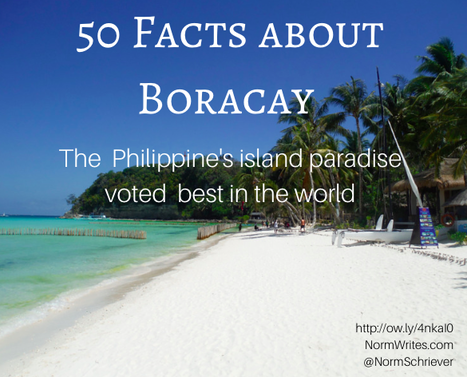
2. Boracay sites at 30 degrees latitude and 121 degrees longitude in the Sibuyan Sea, approximately 196 miles (315 kilometers) south of the Philippine’s capital, Manila and less than 1.25 miles (2 kilometers) from the northwest tip of Panay Island in the Western Visayas region.
3. The island encompasses a total landmass of only 3.98 square miles (10.32 square kilometers), about 4.3 miles (7 kilometers) long and roughly in the shape of a dog bone, less than a kilometer wide at its narrow middle.
4. The Northern and Southern areas of Boracay are more hilly, the highest points reaching about 300 feet (100 meters) above sea level.
5. Boracay has been highly celebrated in the international media as one of the best islands and having one of the best beaches in the world, including by Travel + Leisure Magazine, CNN, the New York Times Travel, and many others.
6. Speaking of beaches, the most famous beach in Boracay – and one of top in the world – is White Beach, a 2.5-mile (4 kilometer) span of uninterrupted white sugary sand that stretches along the western curve of the island, protected from most winds so the turquoise water is usually glassy calm.
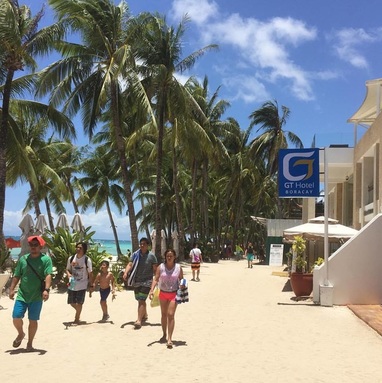
8. Starting with White Beach and extending inland, Boracay is loosely divided into Boat Stations, or just commonly referred to as Station 3, Station 2, and Station 1. Station 3 is the oldest and first inhabited tourism area in the 1990s, Station 2 is home to plenty of hotels, bars, clubs, and the outdoor D-Mall, and Station 1 promotes itself with the mantra, “It’s more fun in Station 1,” (though that hasn’t been officially confirmed.)
9. But centuries before it was a popular tourism destination, the island was home to about 100 indigenous Ati people, who spoke a Visayan language called Inati. They fished, grew rice, corn, and coconuts, and grazed a few goats, living harmoniously off the land in small communities. Later in the 20th century, the locals would fill up cans of puka shells that washed up in abundance of their north shore and sell them by the barrel full to jewelry makers from the cities.
10. The island was first witnessed by Westerners in the 16th century when Spanish explorers came to the Philippines. (The Philippines gained their independence from the Spanish in 1898 when the U.S. intervened.)
11. Where does the name Boracay come from? There are numerous theories, all with good credentials, but none proven as far as I could gather. One popular theory is that name comes from the local Ati word “borac” which translated to “white cotton,” a tribute to perfect white powdery sand on the island’s beaches. Another references the local word ‘bora’ which means bubbles and ‘bocay’ for white.
But when I asked Hayden Fernando, a local who grew up on the island and is now one of Boracay’s , told me that the name comes from ‘Bora,’ which means ‘fine’ in the island dialect, while ‘Bocay,’ the Tagolog (Filipino language) term for a white chicken, or something that is deemed special or rare – like the beauty of the island and its beaches.
12. Around 1900, Filipinos Lamberto Hontiveros Tirol, a judge from neighboring Panay Island, and his wife, Sofia Gonzales Tirol, gained ownership of a significant portion of the island, where they planted coconuts trees, fruit trees, and other crops.
13. The average U.S. tourist didn’t get acquainted with Boracay until the 1970s after the movie Too Late the Hero, which starred Michael Cain and Henry Fonda, was filmed there.
14. But Boracay was a treasure among Hollywood’s movie stars and wealthy celebrities before that. When Philippines President Imelda Marcos attended the World Fair in New York City, she met and befriended the famous starlet Elizabeth Taylor and gave her a bracelet of puka shells from Boracay as a gift. Taylor was so taken by the beauty of the shells that she asked Marcos where they were from. Marcos told her they were from a small remote island in her home country called Boracay that was known for its beauty and beaches, and that she just had to visit some time. Elizabeth Taylor did visit Boracay not long after, and it soon became an idyllic hideaway vacation spot for Hollywood’s elite.
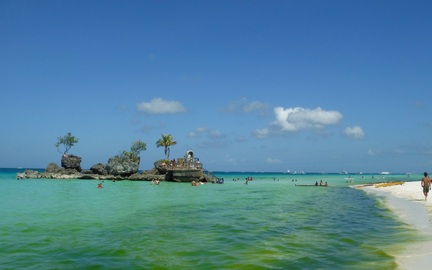
16. While White Beach is gorgeous anywhere you set foot, the grains of sand are noticeably bigger on one end of the island by Station 3, and much finer and smoother by the time you get to Station 1. A local lifeguard told me that an undersea natural channel runs roughly parallel to the beach. As the silt and sand is pushed through the channel by the currents, the heavier and larger pieces sink into the channel and are washed up to the beach closer to Station 3, while the lighter granules stay in the water all the way to Station 1 before being deposited on the beach.
They also say that Boracay’s beaches are so magnificent because most sand is actually finely pulverized stone and volcanic rock, but the island’s sand comes mostly from finely crushed up shells from the nearby coral reefs.
17. These days, the island has about 26,000 permanent or long-time inhabitants. Many more come over from the neighboring island every day just for work, commuting over on small ferryboats.
18. It’s estimated that there are nearly 500 hotels, resorts, and guesthouses on Boracay, with about 2,500 rooms that range from 5-star luxury to simple beach bungalows.
19. But White Beach isn’t the only sandy strip in town, as Boracay also features Puka Beach (known for it’s chilled—out vibe and less crowds), incredibly scenic Diniwid - only accessible by the sea on a path that weaves around, and sometimes through, rock outcroppings, south-facing Cagban Beach where the jetty port sits, and Bulabong Beach.
20. Bulabong Beach hugs the eastern shore of Boracay, unprotected from the sea winds and home to the island’s thriving windsurfing and kite boarding activities.
21. To get to Boracay, you need to find your way to Caticlan – a small town on the island across the channel from Boracay. From the port there, small native outrigger boats called “bancas” come and go all day long, transporting hundreds of tourists, workers, and all of the commercial goods for the island.
22. Luckily, Caticlan has it’s own adorable island airstrip, the Godofredo P. Ramos Airport, which is walking distance or a short trike ride to its ferry port. (Ironically, Caticlan’s airport code is MPH.) Although it’s the most convenient way to access Boracay, flights in and out of Caticlan are often limited to bigger routes like from Manila and Cebu.
23. The flight from Manila is only about 1 hour 10 minutes, and it takes only 35 minutes to get to the city of Cebu.
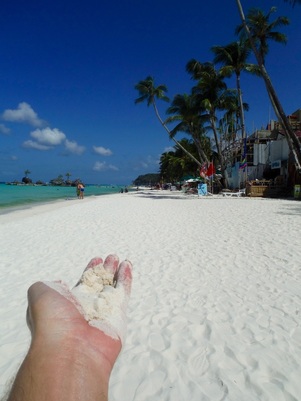
25. Since nothing is simple when traveling in the Philippines, at the ferry terminal, visitors have to pay a Terminal Fee, Environmental Fee, and Boat Fare Fee. While these aren’t expensive, they make you stand in three separate lines at three separate but adjacent counters, though all are required!
26. Many people fly into larger Kalibo airport (code: KLO), about a two-hour van ride shuttle ride south of Caticlan.
27. You’ll hear a melting pot of languages and dialects on Boracay, often including Aklanon (from Aklan province), Hiligaynon, Kinaray-a, Tagalog, Filipino, Chinese, Korean, Russian, Spanish, Italian, French and English.
28. Boracay even has a pleasant and warm Caribbean island feel, with plenty of reggae music and local bands doing spirited renditions of popular Jamaican songs. In fact, Boracay even has its own famous song by Ferns Tosco, I Want to Go Back to the Island of Boracay, as well as no less than thirteen other songs written about it!
29. Popular activities in Boracay include paddle-boarding, scuba diving, helmet diving, snorkeling, windsurfing, kiteboarding, fly boarding, cliff diving, parasailing, zip lining, riding go-carts, golf or just lounging on the beach!
30. Believe it or not, the diminutive island has it’s own golf course, an 18-hole par 72 course designed by Graham Marsh
31. If you want to exercise during your vacation to Boracay (other than running on the beach and swimming in the ocean!), there are a few gyms to check out. A couple of the nice hotels have fitness centers where you can pay a day or weekly/monthly rate, but they can get expensive. Or you can try the local King Fisher Gym, which is cheap and friendly but definitely nothing fancy! The island also has a cool cross fit gym right on the water in Station 1 and a budding mixed marital arts scene at Legacy MMA in Diniwid.
32. About half way between Station 2 and Station 1 on White Beach you’ll notice a unique natural rock formation only a few yards off the shore in the shallow water called Willy's Rock. It’s a Boracay icon and probably the most photographed (and selfied!) landmark on Boracay.
33. Weather in Boracay follows the typical tropical seasons of rainy and dry, called the Amihan (cool northeast wind with moderate temps and no sparse rainfall) and Habagat (southwest monsoon winds and hot, humid weather with heavy rainfall) seasons locally. The Amihan season is usually from mid October to June, and the Habagat season the remainder. The seasons can switch so abruptly that the winds literally shift overnight.
34. Temperatures on Boracay average about Daytime temperatures on Boracay range about 77–90 °F (25–32 °C) from the beginning of the Amihan season into February or March, but increase to 82–100 °F (28–38 °C) in Habagat season, with higher humidity.
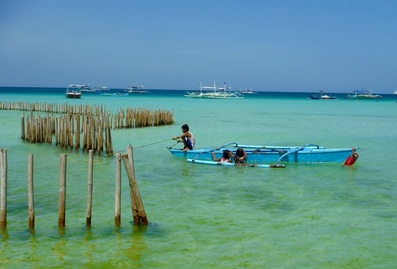
36. Electricity on Boracay is 220 Volts AC and can take Type A American plugs, but not three-pronged plugs or 100/100 V appliances like hairdryers. They sell converters at many shops but check your laptop before you plug it in and I recommend getting a surge protector. The electricity has been known to go on and off especially during storms, and many big hotels and businesses have backup generators.
37. Their currency is the Philippine Peso, and US dollars aren’t commonly accepted. But there are plenty of ATM machines that take international cards and moneychangers are ubiquitous. When the weather is bad and boats can’t make the crossing to the island or the electricity or communications are out, it’s not unheard of for ATMs to be down or out of money. A new system called BoraPay allows members to pay for virtually everything with the swipe of a digitally implanted bracelet so they don’t have to carry cash.
38. These days, a good number of bigger hotels, resorts, and restaurants take credit cards, though you’ll need Pesos at most smaller and local establishments, and you may be charged an additional credit card processing fee.
39. Linguistically lazy tourists sometimes call Boracay “Bora,” which irks natives and long time residents since there is no basis for the abbreviation and it confused the island with Bora Bora.
40. Essential words you need to learn for your Boracay vacation include Mabuhay (a greeting that means ‘welcome’, or ‘to life’), Kamusta (how are you?), Salamat (thank you) and Tagay (cheers.) More
41. Internet access can be challenging at best on Boracay, and often times nearly unusable. Your best bet is to get a local SIM card with national carriers Globe or SMART (I prefer GLOBE) and then access Internet on your phone or device. Almost every hotel and most restaurants and bars have Wi-Fi, the problem is that they just rarely work.
For those of you who need to get some work done while you’re on the island (including writing blog posts with Boracay facts!) there are a couple local Internet cafes that sometimes work, and one hidden treasure of a Wi-Fi connection that I’ve found works like a charm! Drop me an email and I’ll be happy to share that secret spot with you.
42.In the west, we say “Check please” and signal by scribbling a mock signature in the air. On Boracay, they say, “Bill please” and outline a rectangular piece of paper in the air. They also usually say, “I receive X amount of Pesos,” when you hand them money, and have a charming habit of calling foreigners “sir” and “mam” or “boss” to be a little more familiar. But if you listen closely, you’ll hear locals call each other “kuya” or “ate” as a casual reference to male or female friends.
43. Boracay is extra busy on holidays with locals coming in from Manila, and hosts plenty of special events. The Dragon Boat Races are a huge and colorful sporting festival every late April or early May, and the Asian Windsurfing Tour, International Fun Boarding Competition, plenty of beach runs and half marathons, and Open Asian Beach Ultimate Frisbee Tournament are also popular. Concerts, conferences, and special events are always imported to Boracay, and Laboracay brings a insanely crowded, bonkers, spring break-like atmosphere to the island on the Philippine’s Labor Day the first weekend in May.
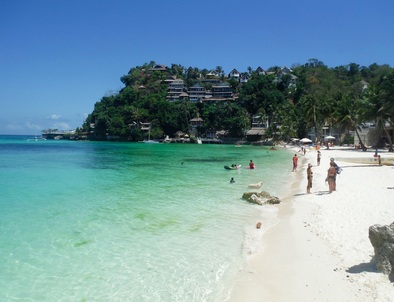
44. Boracay is starting to face a huge conservation problem, as its beaches are being eroded by throngs of tourists and increasing commercialism. While White Sand Beach used to be spotless and immaculate, over the last few years more and more trash is accumulating. PLEASE DON’T LITTER on Boracay – or anywhere else for that matter. Also, you should know that it’s illegal to remove sand, pebbles, or seashells from any of the island’s beaches, per Municipal Ordinance 310. Smoking is also banned on Boracay’s White Beach though far too many people do it anyway and leave their butts in the sand.
45. You’ll still see indigenous Ati on the island, but tragically, most tourists only see them sitting by the beach path and begging. It’s a shame that the island once belonged to them but they’re now reduced to begging. Even though your good intentions may motivate you to hand them some money to help, it’s important to realize that nearly all of these women and children are put out there by gangs, or adults who might be drinking up your money - or worse. So if you want to help, it’s far better to donate to one of the legitimate organizations that effort to improve the education, healthcare, job skills and better the lives of Ati people.
46. On November 8, 2013, Typhoon Yolanda (international name: Haiyan) slammed into the Philippines, killing tens of thousands and burying parts of coastal whole cities in water. With wind gusts up to 278 km/h (235 mph) and 10 meter (30 foot) sea swells, it was considered the strongest typhoon in recorded history ever to make landfall. Yolanda was heading right for the isolated and unprotected island of Boracay, too.
47. I happened to be living on Boracay for a few months that fall. I tried to evacuate to neighboring Patay along with thousands of other stranded tourists and locals, but we were turned away since the Coast Guard shut down all boat traffic off the island 48 hours before the typhoon. Luckily, the heart of the typhoon blew just south of Boracay, so the island was spared the horrors that devastated Leyte, Samara, and Tacloban. I took some video and wrote blogs about the typhoon, that were picked up by international media. https://www.youtube.com/watch?v=rcCigrywbNQ
While there were no official media accounts of fatalities on the island from Yolanda, those of us on the island knew that at least several people were killed by the typhoon and in its aftermath. However, the local government censored any reports of deaths or even injuries, afraid that the truth might scare off some travelers and hurt the inflow of tourism dollars.
48. Boracay is portioned into three “barangays,” or neighborhoods: Manoc-Manoc, Balabag, and Yapak. Even though it is an autonomous, Boracay is administered by the provincial government of neighboring Aklan province, and also governed by the Philippine Tourism Authority.
49. The infrastructure on Boracay is limited, but still more impressive than you might guess. In fact, there is a simple hospital on the island, several private clinics, pharmacies, schools, police stations, an Army outpost, Air Force reserve station, a Coast Guard station, a lifeguard command center at Station 2, water treatment systems, two ice factories, a local radio station called Radio Borcay (106.1FM), radio and 2 cell towers, a Lions Club, a Rotary Club. 3 Baptist churches, 6 Catholic churches, 1 Jehovah’s Witness church, 3 churches of the popular Iglesia de Cristo, and even a mosque on the island.
50. Boracay does have a great squadron of dedicated lifeguards that patrol the beaches and keep people safe, sponsored and trained by the Red Cross. If you’re not a strong swimmer or for children, it’s recommended you swim only between the big red and yellow flags that are placed on the beach, or near a lifeguard tower.
***
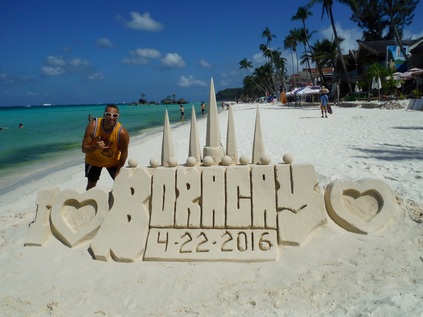
 RSS Feed
RSS Feed